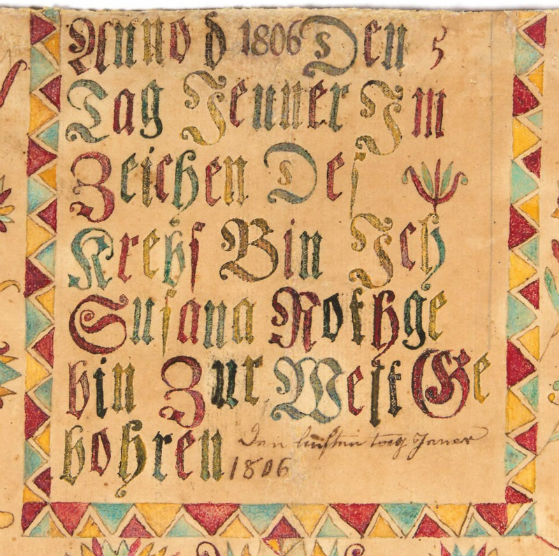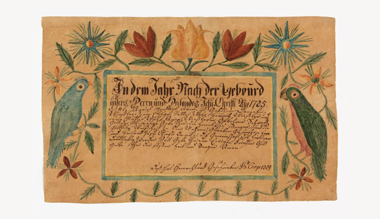
NEW YORK – Fraktur holds an esteemed place in American folk art for its whimsical and colorfully drawn embellishments and its distinctive broken (or fractured) style of lettering. Most pieces were executed in ink and watercolor.
The name fraktur references a font that was popular in Germany for a few hundred years, circa 15th century to early 20th century. The fraktur tradition evolved in America, and Pennsylvania German fraktur has come to signify decorated manuscripts created to document a significant moment in a person’s life.
While marriage and baptismal certificates, as well as birth records, are among the most well-known types of fraktur, house blessings, death certificates, writing samples and awards of merit from a teacher to a student are also highly collected. Considering they were done on thin paper, fraktur examples today mostly survive in good condition, as they would have been cherished by the family for whom they were made and they were often placed in family Bibles.
“Fraktur are watercolor on paper decorative records of birth, marriage, baptism, blessings, death and family histories,” said Ron Pook, founder of Pook & Pook Inc. in Downingtown, Pennsylvania. The most desirable are fraktur that are completely hand drawn and colored taufscheins (birth and baptismal records) that are colorful and detailed.” The auction house has sold many examples of fraktur over the years and in 2004 sold the bulk of Dr. Donald A. Shelley’s fraktur collection for nearly $900,000. Shelley was a longtime collector and authored a groundbreaking text on fraktur years earlier.

The Berks History Center in Reading, Pennsylvania, has a collection of over 500 pieces of hand-drawn fraktur and printed blessings and certificates, which has been noted as a valuable tool for area residents researching genealogy. According to the center, the heyday of fraktur was circa 1745 to 1920 in southeast Pennsylvania (Germantown and Reading were key areas) and these works were mostly made for Lutheran and Reformed families who celebrated baptism as an important sacrament. Fraktur thrived in the state’s Berks and Bucks counties. Itinerant artists brought fraktur to surrounding areas, including Virginia, Maryland, Ohio and even into New England.
Berks County families favored “personalized” forms, according to online commentary by the Berks History Center. “Berks County holds a special place in the field of American fraktur. Its geographically centralized location in southeast Pennsylvania caused major fraktur artists and itinerants to crisscross the county as they carried on a brisk trade in the Taufsclieine market.”

“Some of the Bucks County fraktur are the most intricate examples,” Pook said. “They were primarily drawn by schoolmasters and preachers. Some of the artists were quite prolific and others are very rare to find.”
Certain artists signed many of their works, including Martin Brechall, Daniel Peterman, Johann Heinrich Otto and Karl (Carl) Munch, while others did not sign any works or maybe just a few, Pook added. Many fraktur artists are anonymous.
The content of the fraktur, its design, the family name depicted and whether it was drawn by a known artist are important factors that contribute to its value. In May 1991, a fraktur birth certificate, dated 1808 and signed by Karl Munch fetched $145,000 at Glenn P. Horst’s sale in Ephrata, Pennsylvania, auction, breaking the previous auction record. That example forgoed the usual fraktur decorative motifs, instead featuring four vignettes of the four seasons populated by a father and his son.

Mennonite minister Jacob Strickler (1770-1842) was one of the country’s most renowned fraktur artists, whose influence spread beyond his native Shenandoah Valley in Virginia. His works (and other notable fraktur artists) are in the collection of key museums such as the American Folk Art Museum in New York City as well as other institutions and many personal collections.
Fraktur motifs are mostly decorative and many were copied from early Germanic fraktur from Europe and brought to America, Pook added. Common folky motifs in fraktur include tulips, compass-style flowers, hearts, birds, angels, trees, flowering vines and other flora. A rare fraktur sold at Jeffrey S. Evans & Associates in June 2015 is the only work by Strickler known to feature American Federal-style eagles and it performed well at $26,000. The highest price on LiveAuctioneers’ database is a Johann Conrad Gilbert, Berks County, fraktur birth certificate for Eliesabeth Kunkel, 1815, which made $55,000 in November 2011 at Pook & Pook Inc.
Collectors often pursue fraktur out of an interest in genealogy but mostly for the artistic merits of these pieces. “Collectors are looking for condition, content and color, and outstanding examples of a particular artist,” Pook said.

A new collector should always have an expert look at a piece before purchase, he recommended, noting there are very good reproductions on the market that can easily deceive as well as restoration work that can be hard to detect.
Collectors are drawn to the whimsy and artistic of fraktur and enjoy these colorful works that hearken back to simpler times.



